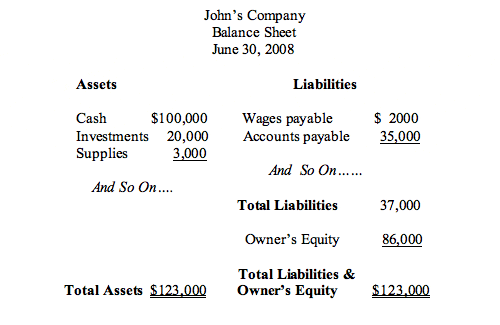Accounting And The Credit Crisis Of 2007/2008 Part I: The Accounting Equation

What Happened?
During the summer of 2007 the financial managers of large U.S. corporations, particularly large investment banks, began to notice a disturbing trend. Each time their companies tried to borrow money using short-term loans (called commercial paper) it became more difficult to locate willing lenders, and for loans that could be obtained, interest rates were becoming noticeably higher. By the fall of 2007, the credit problem had worsened and begun to spread. At the same time that the commercial paper market continued to deteriorate, banks had begun cutting off loans to each other and many mortgage lenders could not obtain funds by borrowing. The problem became especially severe for businesses that were directly or indirectly connected to real estate: home builders, residential lenders, and world-wide banks and investment companies holding securities related to real estate loans as part of their assets. As investors became aware of the problem, they immediately began liquidating their investments in these companies; as the credit fears grew, waves of selling began to wash away values in other companies’ stocks that investors were forced to sell in order to obtain cash. By January of 2008, investment values estimated at more than two hundred billion dollars had disappeared.
As with most financial crises and panics, the source of the events could be traced to over-valued assets. In this case, the assets involved were risky real estate loans to unqualified home buyers (called sub-prime loans). The lenders who made the loans then grouped them together and sold them to large investors, who in turn regrouped them in such a way that they could be sold to other investors, large and small, who collected the loan payments (we will have more to say about this process later in Part II). However, as the borrowers (the home owners) began to default on their loan payments, the values of the loan assets collapsed. Any company either holding or even suspected of holding these types of investment assets soon had difficulty borrowing money as lenders became uncertain about being repaid. Businesses and investors soon suffered the consequences.
One of the key issues in the credit crunch crisis was the lack of “visibility” in financial statements. Over and over in financial reports analysts repeatedly complained that an accurate amount of bad loan assets was not known, and this uncertainty was greatly intensifying the problem by frightening lenders and investors. But how could this be? Aren’t financial statements supposed to show us what a business owns? Shouldn’t risks be apparent? We have to return to basic accounting to begin to answer this question.
The Discovery of the Accounting Equation
We now move back in time from 2007 to 1300. As Europe emerges from the mysticism and ignorance of the dark ages, financial activity, dormant since the fall of the Roman Empire, has begun to flourish. Particularly in Italy, a few insightful merchants are becoming aware of a simple but incredibly powerful concept – the relationship between their wealth and the claims on that wealth. Specifically, the merchants have concluded that the essential description of any financial entity is that the total wealth is equaled by no more than two possible kinds of claims – the creditors and the owner – on that wealth. The merchants come to express this discovery as: Assets = Liabilities + Owner’s Equity. The result of this understanding is that by 1300 the first double-entry accounting records are being used by a few merchants, in which at least two account entries are always required with each transaction in order to keep the equation in balance. By 1458 and then in 1494 the accounting equation concept and rules for double-entry accounting are formalized in two books, first by Benedetto Cotrugli and then more famously by Luca Pacioli, a well-known mathematician and friend of Leonardo da Vinci. Modern accounting, including all its potential complexity, operates within these basic concepts and principles.

The Accounting Equation Today
Over many years, financial reporting to investors and creditors has become the essential product of accounting. The most fundamental accounting report is called the balance sheet, and it is based precisely on the idea of the accounting equation; in other words, the balance sheet summarizes all the account entries into the totals of wealth and the two types of claims on wealth at any point in time. A balance sheet format looks like this:

Result: You can see that the total wealth is $123,000 and is itemized by type of asset. The total liabilities claim on the wealth (business debts) is $37,000 and is itemized by type of liability. Finally, owner’s claim is $86,000 and is simply the difference between the assets and liabilities; that is, how much value would be left over for the owner if all the liabilities were paid. It makes no difference if the business is a one-person business, a partnership, or a large corporation. The basic idea is the same in all cases.
(What about changes in the balance sheet? For example, could we explain the changes between a June 30 balance sheet and a December 31 balance sheet? In fact, yes, there are other financial statements that explain key changes between two balance sheets. These “key” changes are the changes in owner’s equity and cash. For owner’s equity the change statements are called the income statement and statement of changes in owner’s equity (or partners’ equity or stockholders’ equity). For cash, the statement is called the Statement of Cash Flows.)
Reliability Issues – What Can Go Wrong
A balance sheet is the essential financial statement - no information is more fundamental to a business than an accounting of its wealth and the claims on that wealth. However, even when a balance sheet is prepared correctly, two things can go wrong: 1. The transactions that it summarizes were not recorded properly and, 2. Visibility: the user does not have enough knowledge or information to fully understand a balance sheet, including how it might change. There are three dimensions in which these situations occur: classification, valuation, and timing.
Classification means recording a transaction in the correct account category and fully understanding the meaning of the account category. For example, Cash, Investments, Supplies, Wages Payable, and Accounts Payable are all different accounts. For a financial statement user, the difference between seeing an asset classified as $100,000 Cash instead of $100,000 of Supplies could change a decision. Valuation means attaching the correct value to a transaction or account balance. Valuation, particularly for financial assets, can be unpredictable and misunderstood. However, knowing the true wealth of a business depends entirely on accurate valuation. Timing refers to recording an item in the correct accounting period. A financial statement item or value that is misplaced on a June 30 balance sheet instead of on a December 31 balance sheet makes both of the statements incorrect. (For more discussion of these three dimensions, see the prior Professor’s Office article or Volume 1 of Basic Accounting Concepts, Principles and Procedures for an extended discussion.)
Next...
In Part II we will take a closer look at the kind of financial assets that were at the center of the 2007/2008 credit crisis and how accounting rules were used to report them. Then you can decide for yourself: “What happened to the ’visibility’?” “What role did accounting really play in the credit crisis?”
By Greg Mostyn, Mission College
